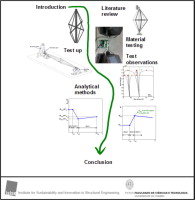Our recent article: “A full scale experimental study of prestressed stayed columns”
Abstract
This paper presents the results of an experimental study on 12 m prestressed stayed columns. In total, 44 tests were carried out to investigate the compressive strength and behaviour of such systems by varying column cross section geometry, diameter of cables, initial pretension level of stays and steel grade. The details of material testing for both steel and cable, and the compressive strength of each specimen including a detailed analysis of results for further numerical and analytical investigations are presented. The applicability of available analytical and design methods for determining the elastic buckling load and the load carrying capacity of stayed columns was assessed. The results provide detailed data on the behaviour of realistic PSSC and highlight the importance of the imperfections and the benefits of such systems.
Graphical abstract
 Graphical abstract
Graphical abstract
Brief introduction
Using slender columns helps structural engineers to design long span structures whereby self-weight is not the dominant load case. However, global buckling becomes a crucial issue in the design of the columns. For slender columns, using high strength steel has little or no effect on the load carrying capacity of slender columns so that the usual solution is to increase the cross-section dimensions. Stayed-columns are known to improve the load carrying capacity of slender columns whenever elastic buckling in compression is the critical failure mode. In fact, adding stays and cross-arms to slender columns can improve both the elastic buckling load and the load carrying capacity as they provide translational and rotational restraint along the length. Fig. 1 illustrates a typical prestressed stayed column (PSSC), comprising a slender column (also known as core or main column), cross-arm members and pretensioned stays (i.e. cables or bars). Commonly, stayed columns have up to three cross-arms along the length (see Fig. 2). Cross-arms have two (plane or planar) or four (spatial or 3D) arms depending on the application. These structural typologies have been investigated experimentally, numerically and analytically by researchers since the 1960’s. 
Fig 1. Prestressed stayed column

Fig 2. Common types of prestressed stayed columns.
Summary and conclusion
This paper has presented the results of an extensive full scale experimental study. In total, 4 simply supported unstayed columns and 40 prestressed stayed columns were tested. Based on the literature review, this is the first experimental study that was performed on a practical length (12 m) with a high initial pretension in the cables.The experimental study covered two distinct steel grades (S355 and S690), two stay cable diameters (10 mm and 13 mm) and five different levels of initial pretension. Besides the obvious confirmation that a properly designed stayed column will significantly increase its ultimate capacity when compared to the corresponding unstayed column, the following conclusions could be drawn from the experimental investigations:
- Adding stay system to long and very slender columns provides effective additional restraint that increases the ultimate capacity of column. This observation confirms similar conclusions from the literature for short stayed columns.
- The main column cross-section has a direct effect on ultimate capacity as it changes the column slenderness and should be directly accounted for in a design method.
- By increasing the initial pretension load in cables the ultimate capacity is also increased and 3Topt should not be taken as the limit for optimised design in practical cases as higher initial pretension may be achieved without relevant additional costs.
- The prestressed columns are highly sensitive to geometric imperfection.
The use of high strength steel showed no benefit for the tested PSSC. This was to be expected as the unstayed core columns exhibited very high slenderness (3.34 to –7.19). Because of laboratory limitations, it was not possible to test larger cross-sections with the same 12 m length, hence the option for the specimens C01–C04. However, testing high strength steel stayed columns was very useful to identify imperfection profiles and to be able to characterise the behaviour of realistic columns for practical application going through a normal fabrication process, as was the case for these test specimens. However, it is expected that the steel grade will become relevant as the cross-section increases, should these PSSC be used, for example, for applied compressive forces in the range of 500 kN. In addition to experimental study, available analytical methods were used for calculating both elastic critical buckling loads and the ultimate capacity of stayed columns. A recently proposed design method [24] showed similar qualitative trends when compared to the experimental results and reasonable scatter in the results (19%). However, reflecting the empirical nature of the method, the results can become progressively unsafe when applied to cases that fall outside its range of applicability. In particular, in order to cover a wider range of practical cases (in the lower slenderness range of the unstayed column) the design method needs to incorporate the normalised slenderness (ratio between elastic critical load and squash load) of the entire stayed column system as a relevant parameter in order to be able to define an equivalent imperfection.
Links to paper
doi:10.1016/j.engstruct.2015.06.033
free access until until August 21, 2015: http://authors.elsevier.com/a/1RIHHW4G46kc-
free access: https://www.researchgate.net/publication/279525893_A_full_scale_experimental_study_of_prestressed_stayed_columns
Link to a simple tool for determining elastic buckling load of prestressed stayed steel columns
http://uk.mathworks.com/matlabcentral/fileexchange/46159-prestressed-stayed-columns-buckling-load

